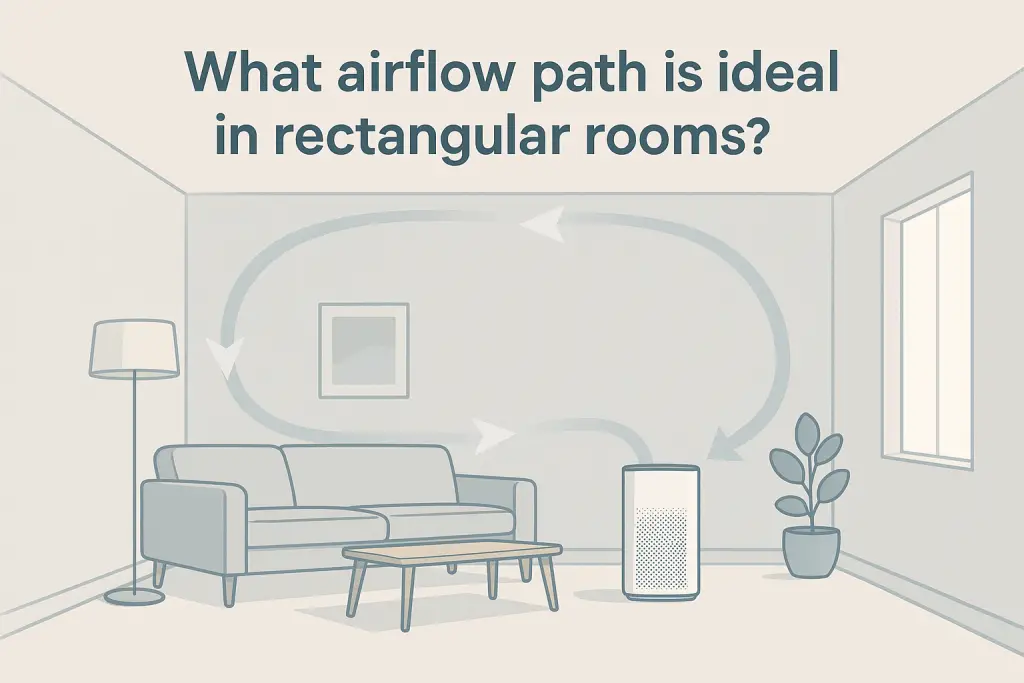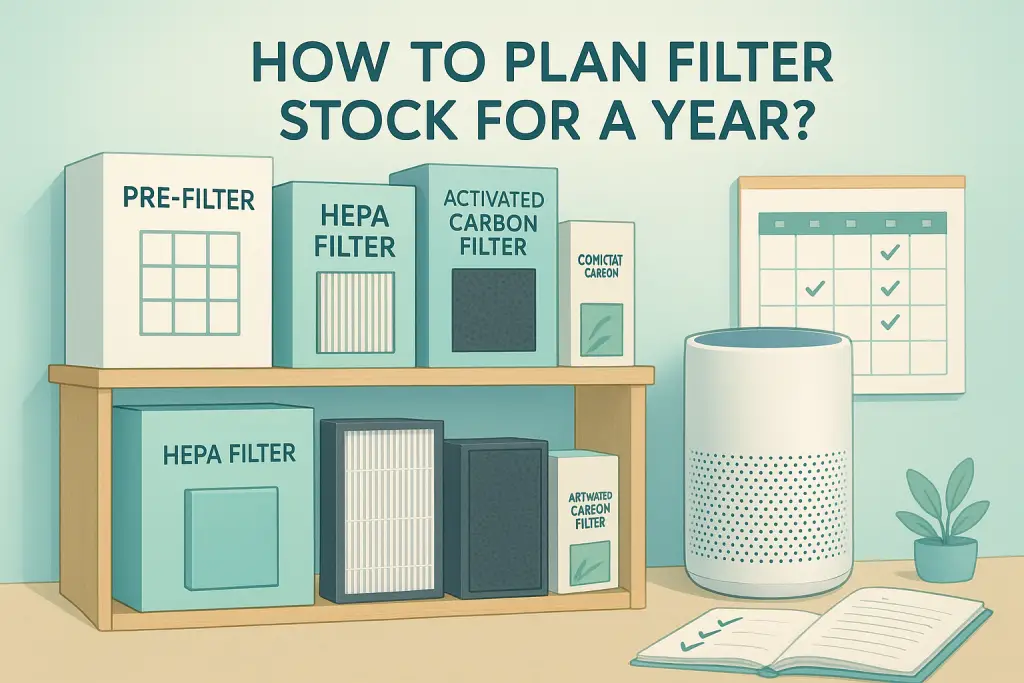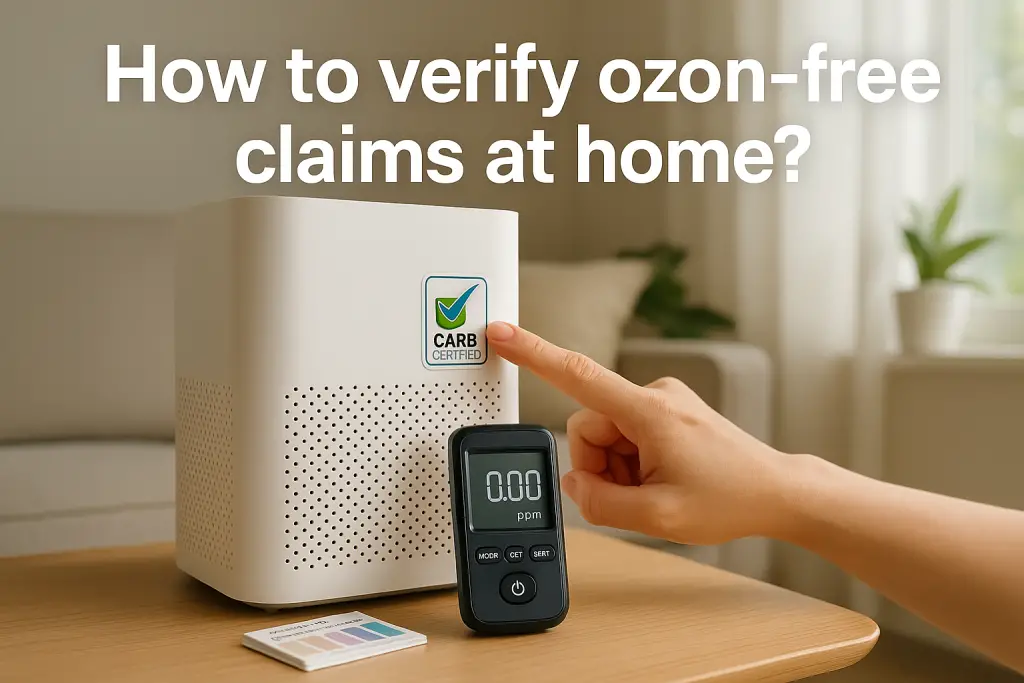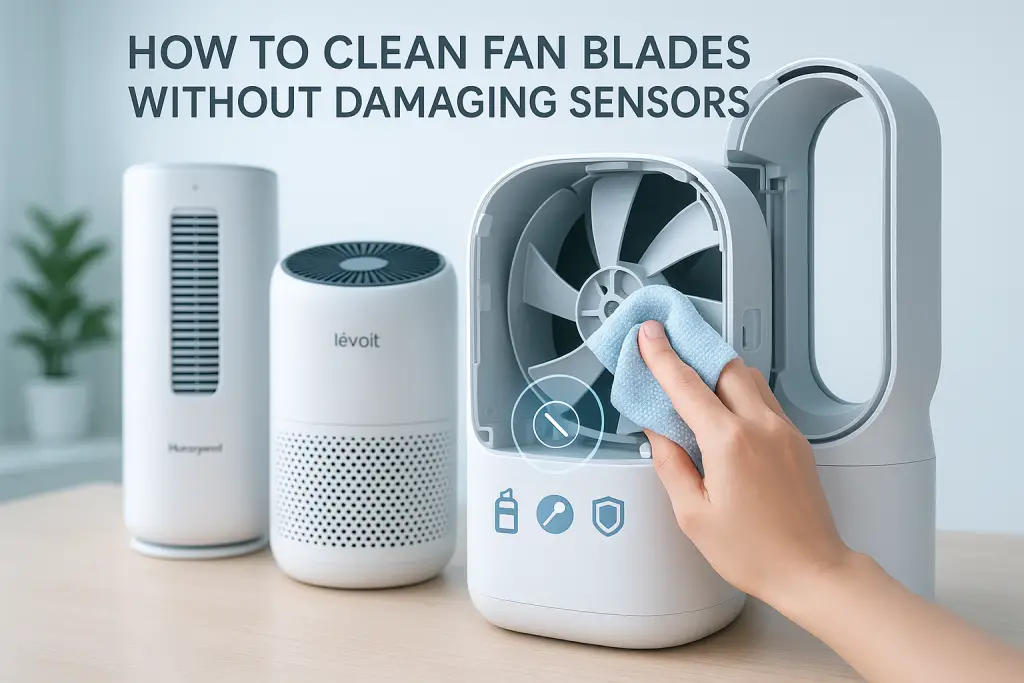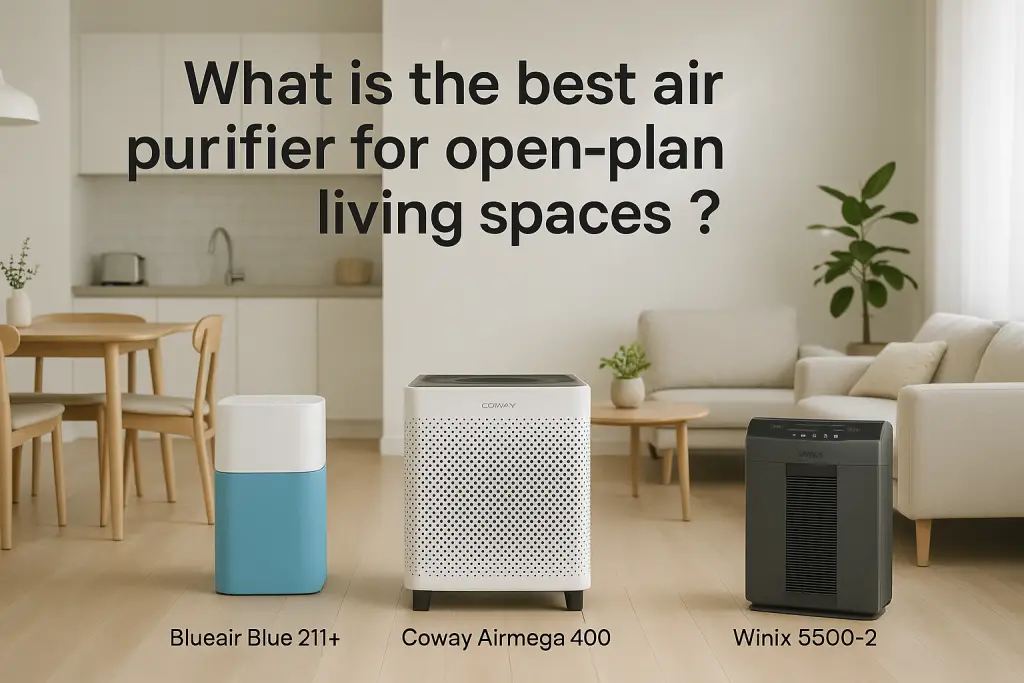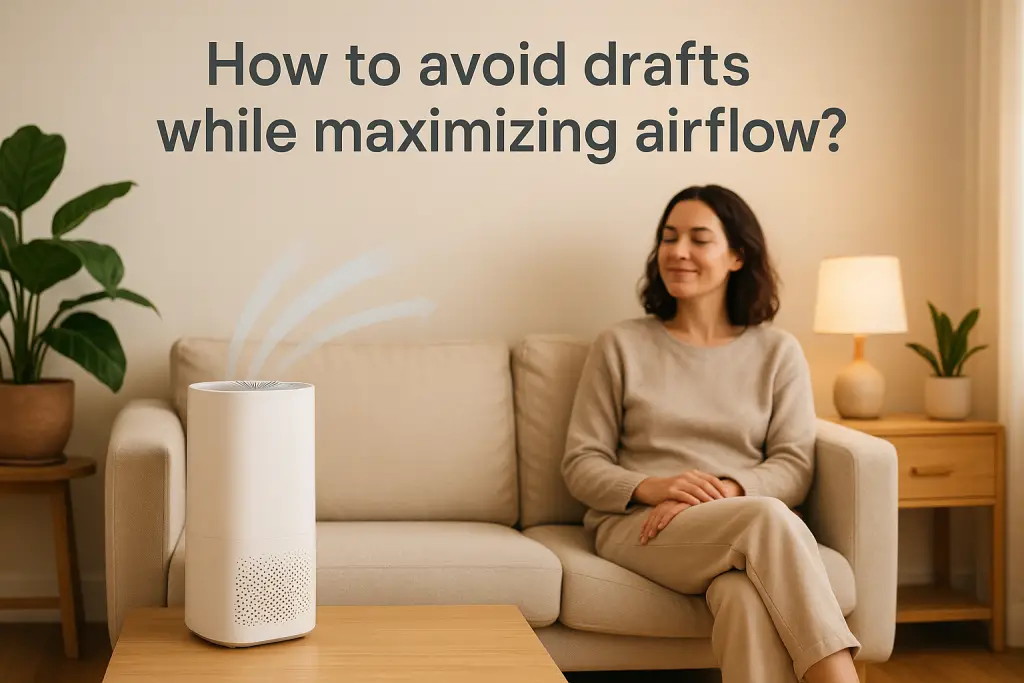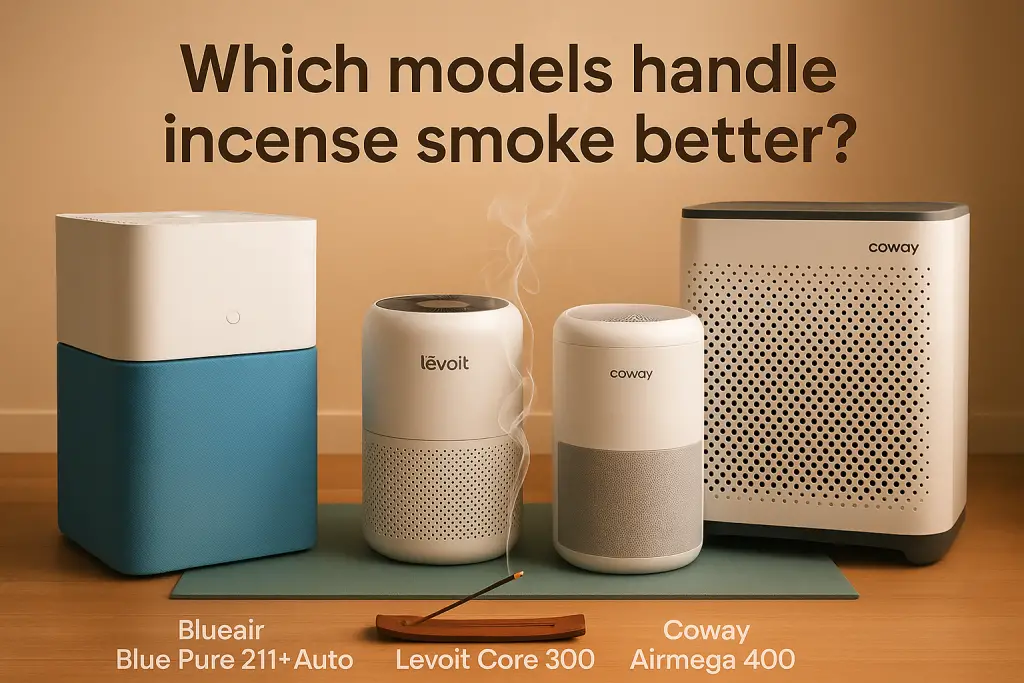The ideal airflow path in rectangular rooms follows a circular pattern that maximizes air purification coverage. For most rectangular spaces, placing an air purifier along the short wall about one-third of the way into the room creates optimal circulation. This strategic positioning helps clean air reach all corners while minimizing dead zones where pollutants can accumulate.
What Airflow Path is Ideal in Rectangular Rooms?
The optimal airflow path in rectangular rooms creates a circular pattern that ensures complete air circulation without leaving dead zones. Unlike square rooms, rectangular spaces present unique challenges due to their elongated shape, which can create stagnant areas in corners and along longer walls. According to the Environmental Protection Agency (EPA), proper air purifier placement can improve filtration efficiency by up to 50% compared to random positioning.
Rectangular rooms naturally develop a primary air circulation loop, with air typically flowing upward near heat sources (like electronics or sunny windows), across the ceiling, down the opposite wall, and back across the floor. Understanding this natural pattern is essential for positioning your air purifier to work with, rather than against, these existing air currents.
How Room Dimensions Affect Airflow Patterns
The specific dimensions of your rectangular room significantly impact how air circulates and where dead zones occur. The length-to-width ratio is particularly important in determining the natural airflow pattern.
Most American homes feature rectangular rooms with length-to-width ratios between 1:1.5 and 1:2. In rooms with a 1:1.5 ratio (moderately rectangular), air tends to circulate in a more balanced oval pattern. In longer rooms with a 1:2 ratio or greater, air circulation becomes more stretched, creating potential dead zones in far corners.
Ceiling height also plays a crucial role in vertical air movement. Rooms with standard 8-foot ceilings develop different circulation patterns than those with vaulted or high ceilings. Higher ceilings create stronger vertical thermal currents but may require more powerful air purifiers to maintain effective circulation through the larger volume of air.
Common Airflow Obstacles in Rectangular Rooms
Several common features in rectangular rooms can disrupt ideal airflow patterns:
- Large furniture: Pieces placed against walls can block natural air circulation, creating stagnant zones behind them
- HVAC vents: Heating and cooling vents create their own strong airflow currents that may conflict with or enhance your air purifier’s effectiveness
- Doorways and windows: These openings create cross-ventilation that alters air movement patterns
- Room dividers: Partial walls, bookcases, or screens can split airflow into separate zones
- Electronic equipment: Computers, TVs, and other devices generate heat that creates localized convection currents
Understanding these obstacles helps in developing strategies to avoid drafts while maximizing airflow in your living spaces, ensuring both comfort and clean air.
Optimal Air Purifier Placement for Rectangular Rooms
Based on fluid dynamics principles and extensive testing, the ideal airflow path for an air purifier in a rectangular room follows specific positioning guidelines:
- Primary recommendation: Place your air purifier along one of the short walls, approximately one-third of the way into the room. This position allows the device to work with natural circulation patterns.
- Direction: Point the air output toward the center of the longest wall. This creates a circular airflow pattern that maximizes coverage throughout the room.
- Height: Position the air purifier 3-5 feet off the ground for optimal air mixing. This height helps capture both rising hot air and falling cooled air.
- Clearance: Maintain at least 12-24 inches of space around all sides of the purifier to avoid restricting airflow.
This placement strategy creates a consistent circular airflow path that draws in polluted air from throughout the room while distributing clean air to all corners. When selecting the best unit for your space, consider best air purifiers by room size to ensure adequate coverage for your specific dimensions.
Placement Strategy Based on Room Dimensions
Different rectangular room dimensions require specific placement strategies to achieve optimal airflow patterns:
- Long rectangular rooms (1:2 ratio or greater): Consider placing the air purifier one-third of the way along the long wall, pointed toward the center of the opposite wall. In very long rooms, two purifiers placed at the one-third and two-thirds points may be necessary.
- Standard rectangular rooms (1:1.5 ratio): Position the purifier on the short wall, one-third of the way into the room, directed toward the center of the opposite long wall.
- Nearly square rooms (1:1.2 ratio): Place the purifier in a corner, angled toward the center of the room to create a diagonal airflow pattern.
For rooms with higher ceilings (9+ feet), position the purifier slightly higher than usual to better capture the larger vertical air columns that develop in these spaces.
Multi-Purifier Strategy for Larger Rectangular Spaces
For rectangular rooms exceeding 400 square feet, a single air purifier may not provide adequate coverage. In these cases, high CADR air purifiers for large rooms are essential, but you may still need a multi-purifier strategy:
- Two-purifier setup: Place one unit on each of the short walls, positioned one-third of the way into the room. Direct both units to blow air in the same circular direction.
- L-shaped rooms: Treat each section as a separate rectangular area, with purifiers positioned according to the guidelines for each section.
- Open floor plans: Use natural boundaries like furniture groupings to define rectangular zones, and place purifiers accordingly.
When using multiple units, ensure they work cooperatively rather than creating conflicting airflows. Position them so their output streams don’t directly oppose each other, which can create turbulence and reduce efficiency.
Scientific Testing Methods to Verify Optimal Airflow
After positioning your air purifier, verify you’ve created the ideal airflow path using these testing methods:
- Smoke test: Light an incense stick or use a smoke pencil ($15-30) in different areas of the room. Watch how the smoke moves to visualize airflow patterns and identify any dead zones.
- Ribbon test: Attach lightweight ribbons or tissue strips to dowels and place them in various locations. Their movement indicates airflow direction and strength.
- Particle counter test: Use a portable air quality monitor ($100-300) to measure particulate levels in different areas of the room before and after running your air purifier.
For a comprehensive test, create a grid pattern dividing your rectangular room into sections. Test each section to ensure even air circulation throughout the space. This methodical approach helps identify problem areas that may need adjustment.
Interpreting Your Airflow Test Results
Understanding what your airflow tests reveal can help you fine-tune your air purifier placement:
- Good airflow indicators: Smoke moves in a consistent circular pattern; ribbons show gentle movement in all areas; particle counts decrease evenly throughout the room
- Dead zone indicators: Smoke hangs in certain areas; ribbons remain still; particle counts remain high in specific locations
- Airflow obstruction signs: Swirling or erratic smoke patterns; ribbons showing turbulent movement; inconsistent particle reduction
If you identify dead zones, consider adjusting your purifier position or adding a small fan to help distribute air to these areas. For families with young children, pay special attention to airflow in children’s rooms where special IAQ considerations may be necessary for their developing respiratory systems.
Integration with Existing Air Systems in Rectangular Rooms
Creating the ideal airflow path requires coordination between your air purifier and existing air systems:
- HVAC coordination: Position your air purifier away from direct HVAC vents to prevent interference with its intake. If possible, place the purifier perpendicular to airflow from vents rather than directly in their path.
- Ceiling fans: Use ceiling fans on low speed to enhance air mixing without creating strong currents that might disrupt the purifier’s effectiveness. In summer, set fans to rotate counterclockwise; in winter, set them clockwise.
- Window management: Consider how open windows affect room airflow. Position the purifier between common pollution sources (like windows facing busy streets) and the room’s occupancy area.
For whole-house considerations, you might evaluate the benefits of whole-home vs. room purifiers to determine the most effective approach for your entire living space.
Smart Technology for Airflow Optimization
Advanced air purifiers with smart features can help optimize airflow paths by adapting to changing conditions:
- Auto-mode functionality: Sensors detect pollution levels and adjust fan speeds accordingly, helping maintain optimal airflow even as conditions change
- Air quality monitoring: Real-time data helps verify that your placement is working effectively
- Smart home integration: Coordination with other devices like thermostats can help create consistent airflow patterns
- Usage pattern learning: Some advanced models track effectiveness over time and suggest optimal operational hours
When selecting smart purifiers, look for models with multi-directional sensing capabilities that can detect air quality in different parts of the room, not just near the unit itself.
Solving Common Airflow Problems in Rectangular Rooms
Even with optimal placement, you may encounter specific airflow challenges in rectangular rooms:
- Corner dead zones: Place a small desktop fan in corners to boost circulation or angle your purifier slightly toward problem corners
- Multiple doorways: Position your purifier away from high-traffic pathways while still maintaining the one-third room position rule
- Limited placement options: When ideal positioning isn’t possible, prioritize placing the purifier between common pollution sources and the areas where people spend the most time
- Furniture blockage: Rearrange furniture to create clear airflow paths, ensuring at least 3 feet of open space in front of air purifier outputs
For living areas with multiple seating arrangements, consider the specific challenges in living room IAQ, seating, drafts, and flow to create comfortable, clean air zones for everyone.
Addressing Room-Specific Airflow Challenges
Different types of rectangular rooms present unique airflow challenges:
- Bedrooms: Position purifiers at least 3 feet from the bed, ideally on the wall opposite the headboard. Choose quieter models for sleeping areas.
- Living rooms: Place purifiers near but not directly beside common sitting areas, accounting for furniture blockages.
- Home offices: Position the purifier between you and equipment that generates heat (computers, printers), as these create rising air currents that can be utilized.
- Nurseries: For newborn and kids’ rooms, quiet and safe IAQ is essential. Place purifiers farther from cribs (at least 6 feet) but still within the ideal circulation path.
In each case, the goal remains creating a complete circulation pattern while addressing the specific needs and challenges of the room type.
Seasonal Adjustments to Maintain Ideal Airflow Paths
Air circulation patterns change throughout the year, requiring seasonal adjustments to your air purifier placement:
- Winter adjustments: Heating systems create strong rising air currents near vents and radiators. Position purifiers opposite these heat sources to work with the natural convection cycle.
- Summer strategies: Air conditioning creates downward cool air flows. Place purifiers slightly higher in summer to better capture this pattern.
- Spring/fall considerations: During mild weather when windows are often open, position purifiers between windows and room centers to capture incoming pollutants.
- High pollution events: During wildfire season or high pollen days, move purifiers closer to windows (even when closed) to capture particles that infiltrate from outside.
Seasonal adjustments of just 2-3 feet in purifier positioning can significantly improve performance as airflow patterns change with heating and cooling needs.
Expert Recommendations for Specific Air Purifier Types
Different air purifier designs create distinct airflow patterns, requiring specific placement strategies:
- 360° intake models: These units (like cylindrical tower purifiers) draw air from all directions and work well when placed near the center of short walls in rectangular rooms.
- Directional intake designs: Models with front or back intakes should be positioned with their intake facing the longest open area of the room.
- Tower designs: These tall, narrow units work well in corners or along walls where floor space is limited. Place them along the short wall, one-third into the room.
- Console models: These larger units typically draw air from the front and expel it upward or from the top. Position them along walls with clear space above for optimal output flow.
For any design, ensure the intake remains unobstructed and the output can flow freely into open space rather than directly against a wall, furniture, or curtains.
Conclusion: Creating Your Customized Rectangular Room Airflow Strategy
The ideal airflow path for air purifiers in rectangular rooms follows a circular pattern that maximizes coverage while minimizing dead zones. By positioning your purifier along the short wall, approximately one-third into the room, you create an efficient air circulation loop that cleans the entire space.
Remember that room dimensions, furniture placement, existing air systems, and seasonal factors all influence the optimal placement. Use the testing methods described to verify your setup is working effectively, and don’t hesitate to make adjustments based on your findings.
By applying these scientific principles to your specific situation, you can significantly improve your air purifier’s effectiveness and enjoy cleaner air throughout your rectangular living spaces.
When to Consult Professional Help
While most airflow optimization can be done independently, consider professional assessment in these situations:
- Persistent air quality issues: If you’ve tried multiple positions but still experience poor air quality
- Complex HVAC systems: Homes with zoned heating/cooling or specialized ventilation may require professional analysis
- Health-sensitive occupants: For individuals with severe allergies, asthma, or other respiratory conditions
- Unusual room configurations: Extremely long rooms, multi-level spaces, or rooms with complex architectural features
Professional indoor air quality consultants or HVAC specialists can provide detailed assessment using advanced tools like computational fluid dynamics modeling to visualize and optimize airflow throughout your home.
| Photo | Air Purifier Model | Best for | Price |
|---|---|---|---|

|
WINIX A231 Air Purifier | Asthma & Indoor Pollution | Check Price On Amazon |

|
Rabbit Air, A3 SPA-1000N Air Purifier | Pet Dander & Odors | Check Price On Amazon |

|
LEVOIT Air Purifier | Best Overall | Check Price On Amazon |

|
GermGuardian Air Purifier | Cigarette & Cooking Smoke | Check Price On Amazon |

|
Coway Airmega Air Purifier | New-borns | Check Price On Amazon |

|
BLUEAIR Air Purifier | Germ & Virus Control | Check Price On Amazon |
